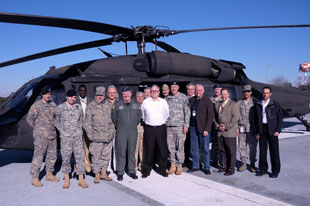USAARL Hosts International Meeting

The U.S. Army Aeromedical Research Laboratory at Fort Rucker, Ala. hosted the NATO RTO RTG-184 "Safe Ride Standards for Patient Evacuation using Unmanned Aerial Vehicles" Working Group meeting Jan. 24-28.
At the invitation of Col. Joe McKeon, USAARL commander and John Ramiccio, chief of USAARL's Flight Systems Branch and NATO Working Group member, military officers and dignitaries from organizations representing the U.S. Army, Navy, Air Force, and Air Force Special Operations Command, British Royal Air Force, and Israeli Defense Force participated in the meeting. UAV industry leaders also attended.
Since the 1920s, aeromedical evacuation has been conducted on-board fixed and rotary wing aircraft. The gravitational forces (G-forces) experienced by injured patients on-board the aircraft are within human tolerance limits because the forces are controlled by on-board pilots. UAVs can pull G-forces far greater than traditional medical evacuation aircraft. In order for UAVs to be used for far-forward medical evacuation, safe ride standards for injured patients are critical to UAV developers who need to ensure their airframes are suitable for medical evacuation.
Retired German Air Force Brig. Gen. Dr. Erich Roedig, MD, CFS, former Surgeon General of the German Air Force and chairman of the NATO Working Group, opened by thanking USAARL for hosting the meeting. "Fort Rucker is a nice place to visit, not only because it's sweet home Alabama but also because it's the well-known and respected home of Army aviation," said Roedig.
He also said, "I am privileged and quite proud to chair this panel of aviation, medical transport, and UAV experts. We have hard work in front of us. I hope this meeting will bring us a huge step forward in our work so that 1 year from now we will have reached our goal of developing safe ride standards for wounded Warriors being transported on-board UAVs."
According to the NATO Technical Activity Proposal, the agenda included topics such as 1) the development and flight characteristics of UAVs; 2) the control mechanisms (remotely piloted vs. on-board programming) for UAVs; 3) the use of UAVs for casualty evacuation; 4) the G-tolerance and rate-of-onset tolerance of patients with differing medical conditions; and 5) in-flight medical monitoring.
While UAVs are not part of current U.S. Army medical evacuation doctrine, "we continue to move forward with research and technology demonstrations because what we are doing here is for the user, our Joint Coalition and NATO Forces. Our work will ultimately benefit the Warfighter," said Col. Robert Mitchell, director of the U.S. Army Medical Evacuation Proponency and Working Group member.














